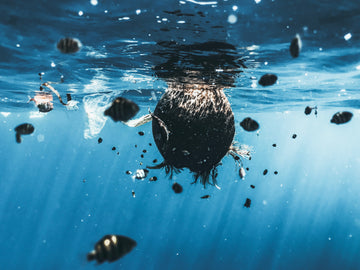Plastic pollution is one of the worlds biggest problems to this day. The Earth's ecosystems are filled with plastic, big and small, that aren’t going anywhere, anytime soon. Plastic actually has quite a short history. The first synthetic plastic was produced in the early 1900s, and since then it has grown to become the most mass-produced material in the world. Because plastic is so durable, versatile, and malleable, it quickly became one of the most used materials. Consumers saw how longlasting it was, and started to replace many household items like glass plates, cups, and storage containers, with new plastic versions. Little did we know that this small change would make a huge impact on the earth just over 100 years later.
What is polluting the ocean?
If you really think about it, most of the daily items you use contain some sort of plastic. If you take a second and go through your daily routine, you can see just how many of the products you use are either packaged in plastic, contain plastic particles, or are just straight up plastic. When you wake up in the morning, you shower using a plastic soap bottle, brush your teeth using a plastic toothbrush, and eat breakfast off of a plastic plate while drinking coffee from a plastic to-go cup. Of course this isn't the case for everyone, but if even a fraction of the 7 billion people on our planet live this way, that is an insane amount of plastic waste that will eventually end up in our oceans or landfills. Plastic is not biodegradable, meaning it can not be decomposed naturally by living organisms or bacteria. Because of this, there is no good way to dispose of plastic and it can last in a landfill for up to 1,000 years. Unless it's recycled, plastic will end up as pollution. The most common types of plastic pollution are water bottles, plastic bags, bottle caps, and styrofoam cups. Our oceans are getting hit hard by these plastics. Everyday, 8 million pieces of plastic pollution make their way into the ocean, which adds to the estimated 5.25 million macro and microplastic pieces floating in the open ocean already. This pollution can be anything from microplastic pieces to huge industrial fishing nets. This problem has to stop!
How does plastic end up in the ocean?
Plastic can end up in the ocean many ways. Plastic is either not properly disposed of and littered, or it ends up in trash bins around the world. Because plastic is so lightweight, it can be blown around and transported easily, thus getting carried right into the ocean. When it comes to clothing, plastic microfibers can shed in the washing machine which then gets carried into the waterways and eventually the ocean. Other plastic is either purposely or accidentally dumped from cargo ships. The sad fact of the matter is that many countries do not care about their waste and where it ends up, so many places purposely blind themselves to the harm that their waste dumping causes. This is a big part of why our oceans and beaches are harmed by pollution and waste.
What is the great pacific garbage patch?
The Pacific Ocean is an expansive ecosystem, home to millions of living creatures. It covers 30% of the world's surface. Unlike the common belief that the Great Pacific Garbage Patch is concentrated in one spot, it spans across the Pacific Ocean, creating an eastern garbage patch between California and Hawaii, and a western garbage patch located near Japan. It is made up of marine debris, mainly plastic pollution. About 54% of the waste in the GPGP comes from land based activities in North America and Asia. The pollution can contain anything from microplastics, to fishing nets, to boat engines. The debris is mixed together and eventually gathers due to the wind and currents. Much of the plastic goes through a process called photodegradation which is where the sun breaks down the bigger pieces into smaller microplastics. On the other hand, some of the debris in the GPGP are over 50ft long, including giant industrial fishing nets. Research has estimated that about 70% of marine debris actually sinks to the bottom of the ocean. Due to the North Pacific Subtropical Zone, the garbage patches are linked together and create almost a continuous circle of floating trash. It isn't always visible to the human eye, but it does significant damage on the ecosystem that is the Pacific Ocean.
The effects of the GPGP: Why is ocean pollution a problem?
Marine species are often the victim of plastic pollution in the ocean, but the great pacific garbage patch takes that to a whole other level. Many times, ocean animals confuse plastic for food. For example, sea turtles love to feed on jellyfish, and when they see a plastic bag floating in the water, they often mistake that for dinner. Many other fish resort to eating the small microplastics. Plastic is known to give off a similar scent to their normal food. Many birds dive in the water to get fish, and end up also eating small microplastics. Many other animals are harmed by getting caught in the plastic. Dolphins, seals, and turtles are known for getting caught in fishing nets. The algae and plankton are also affected by the plastic wasteland. The debris sitting on top of the ocean blocks sunlight from reaching them, which is what they need to grow and survive. Because plankton and algae are the base of many life forms, when they get damaged, it hurts the entire ecosystem and food chain. On top of all of that, plastic contains harmful chemicals that can leak into the water around them, affecting us humans as well. When marine animals ingest these chemicals, so do the humans that eat them. One study found that humans unknowingly eat thousands of microplastics every year, which can equal up to a credit card’s worth of plastic each week. Yuck!
Solutions to plastic pollution
The Great Pacific Garbage Patch is such a big problem that no nation will take responsibility. Cleaning up the debris would be virtually impossible and would need an unthinkable amount of funding. Essentially, any country would go bankrupt trying to get rid of the debris. The pollution is also incredibly hard to clean up without harming any marine life in the process. It’s thought to be twice the size of Texas, however contrary to popular belief, you can't see the Great Pacific Garbage Patch from space. Fortunately, there are ways to at least reduce, if not eliminate the amount of waste being added. The best thing to do to help the problem is to reduce the amount of single use plastic we use. Instead of plastic plates, cups, and water bottles, choose reusable alternatives. Deny straws, plastic bags, and to-go containers when possible and test out products that are made from wood, algae, or bamboo. Cut balloons out of your birthday celebrations, since they often float away and end up in the ocean. Purchase second hand products, use sustainably sourced clothing, recycle old items, and of course, shop environmentally-friendly brands.






